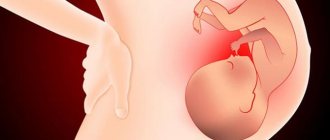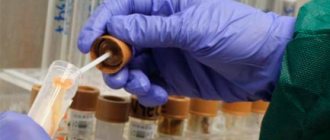The role of lactobacilli in the vaginal microflora
Lactobacilli in the vagina are found in quantities of about 109 CFU/ml (colony-forming units observed in 1 milliliter of vaginal discharge), which is up to 95–98% of the total number of all microflora microorganisms. The predominant representatives of lactobacilli in the vaginal environment are L. acidophilus, L. plantarum, L. fermentum and L. casei, which, depending on the individual characteristics of the woman’s reproductive system, can be present in different proportions.
During their life, these microorganisms produce lactic and other organic acids, which provide the necessary pH of the vaginal environment. Creating the correct level of acidity allows you to suppress the activity of other bacteria and fungi present in the microflora, an increase in the concentration of which can lead to infectious and inflammatory diseases of the female genital area. In addition, lactobacilli of the vaginal microflora produce antibacterial substances (hydrogen peroxide and bacteriocins) that inhibit the vital activity of pathogenic microorganisms and cause their death.
Thus, it is impossible to overestimate the importance of lactobacilli for a woman’s health - they can rightfully be considered one of the most important factors in the arsenal of the body’s defense mechanisms.
Lactobacillus (lactobacteria or lactobacilli, a genus of bacteria)
Lactobacilli
(lat.
Lactobacillus
) is a genus of gram-positive anaerobic non-spore-forming lactic acid bacteria.
Also called lactobacilli
. Lactobacilli usually have a regular long “rod” shape, sometimes coccoid, located in short chains or singly. During their normal metabolism, lactobacilli are able to form lactic acid, hydrogen peroxide, produce lysozyme and substances with antibiotic activity: reuterin, plantaricin, lactocidin, lactolin. Heterofermentative species of lactobacilli can also produce acetic acid and carbon dioxide as end products.
Lactobacilli are normal human microflora
Many species of lactobacilli (lactobacillus) are normal microflora of the gastrointestinal tract, from the oral cavity to the colon. Previously, it was believed that lactobacilli were practically absent in the stomach (102–103 CFU/ml of gastric juice). However, in 2005, in the stomach of healthy people, strains of lactobacilli were discovered that, like Helicobacter pylori
to exist in the sharply acidic environment of the stomach:
L. gastricus, L. antri, L. kalixensis, L. ultunensis
(Y.S. Zimmerman).
In the small intestine there is a small amount of lactobacilli located in the parietal layer (103–104 CFU/ml of intestinal juice). In the colon, there are significantly more lactobacilli (106–107 CFU/g of feces), they are represented by the following species: Lactobacillus acidophilus, Lactobacillus casei, Lactobacillus bulgaricus, Lactobacillus plantarum, Lactobacillus salivarius, Lactobacillus reuteri, Lactobacillus rhamnosus
and others. By direct contact with enterocytes, lactobacilli (like bifidobacteria) stimulate the defense mechanisms of the human body, including increasing the rate of regeneration of the mucous membrane, influence the synthesis of antibodies to related but pathogenic microorganisms, activate phagocytosis, as well as the synthesis of lysozyme, interferons and cytokines . Lactobacilli produce a number of hydrolytic enzymes, in particular lactase, which breaks down lactose (milk sugar) and prevents the development of lactase deficiency. Lactobacilli maintain the acidity of the colon at a pH level of 5.5–5.6.
Lactobacilli are present in breast milk.
Some relationships (associations) between lactobacilli and human diseases
Lactobacillus correlates with obesity; the titer of lactobacilli decreases in inflammatory bowel diseases and diabetes mellitus, chronic kidney disease; the titer of Lactobacillus fermentum
increases in esophageal adenocarcinoma (Karpeeva Yu.S., Novikova V.P., Khavkin A.I., etc.).
Lactobacilli - normal and pathogenic microflora of the vagina
Lactobacilli (lactobacillus) are the predominant type of normal microflora of the vulva and vagina (106-109 CFU/ml of discharge). The main types of lactobacilli present in the vagina are the following: Lactobacillus acidophilus, Lactobacillus casei, Lactobacillus fermentum, Lactobacillus cellobiosum
. The main functions of lactobacilli in the vagina are to maintain an acidic environment and suppress the growth of opportunistic microorganisms. Previously, all lactobacilli found in the vagina were called Doderlein's bacilli (in honor of the German gynecologist A. Doderlein, 1860–1941).
Lactobacilli L. crispatus, L. gasseri, L. jensenii and L. iners
along with
Atopobium vaginae, Leptotrichia amnionii, Sneathia sanguinegens, Eggerthella spp.
associated with bacterial vaginitis (Murtazina Z.A. et al.).
Lactobacilli - probiotics
The genus Lactobacillus, along with the genus Bifidobacterium, contains the largest number of species and individual strains of probiotics. In general, probiotics are microorganisms that have been scientifically shown to be beneficial to your health. Some types of probiotics are part of the human microflora, some are close to the microorganisms found in humans. Different strains may benefit different organs in different ways. For example, the Shirota
the Lactobacillus casei
species supports the immune system and helps move food through the intestines, the
Bulgaricus
of
the Lactobacillus delbrueckii
is useful for patients who are unable to digest lactose contained in natural milk and most dairy products (Probiotics. What are they and what can they do? ).
Not all species and strains of lactobacilli are probiotics. Specific probiotic species and strains of lactobacilli included in various medications, dietary supplements and products are listed below.
Lactobacilli in medicines and dietary supplements
Lactobacilli is the international nonproprietary name (INN) of the drug. According to the pharmacological index, Lactobacilli belong to the group “Medicines that normalize intestinal microflora”. According to ATC, lactobacilli are included in the following groups:
- "A07 Antidiarrheal drugs", code "A07FA01 Microorganisms producing lactic acid" and
- "G01 Antiseptics and antimicrobials for the treatment of gynecological diseases", code "G01AX14 Lactobacilli".
Various species and strains of lactobacilli are widely used in medicines, including probiotics for the treatment of dysbiosis of various etiologies, diseases of the oral cavity, urogenital area, gastrointestinal disorders, as well as in dietary supplements. Below are some examples of which medications and dietary supplements include this strain:
- Lactobacillus acidophilus
, strains NK1, 100ash and K3Sh24 - drug Acylact - Lactobacillus acidophilus
, strains NK1, NK2, NK5 and NK12 - drug Acipol - Lactobacillus acidophilus
, strain 12b - medicinal product Biobakton dry - Lactobacillus acidophilus
, strain LA-5 - dietary supplement Bifiform Complex - Lactobacillus acidophilus
, strains D No. 75 and D No. 76 - Vitaflor dietary supplement - Lactobacillus acidophilus sp.
L. gasseri - drug Linex - Lactobacillus acidophilus
, strain K/A R-08 - dietary supplements Vitanar and Gialakt - Lactobacillus casei
, strain KNM-12,
Lactobacillus acidophilus
, strains NK1,
Lactobacillus plantarum
, strain 8P-A3 - dietary supplement Normospectrum - Lactobacillus delbrueckii ssp bulgaricus
, strain 51 - dietary supplement Sano-gastril - Lactobacillus fermentum
, strain 90T-C4 - medicinal product Lactobacterin and dietary supplement Hyalact - Lactobacillus fermentum
, strains 39 - drug Lactobacterin - Lactobacillus plantarum
, strains 38, 8P-A3 - drug Lactobacterin - Lactobacillus rhamnosus
, strain LGG (ATCC 53103) - dietary supplements Bifiform Malysh and Bifiform Complex (Denmark), Culturelle (USA) - Lactobacillus reuteri
, strain ATCC 55730 - BioGaia (BioGaia Biologies, USA) - Lactobacillus reuteri
, strain DSMZ17648 (Pylopass™) - Helinorm dietary supplement used to reduce the contamination of the gastric mucosa by
Helicobacter pylori - Lactobacillus rhamnosus
, strain GR-1 and
Lactobacillus reuteri
, strain RC-14 - dietary supplement Vagilak (Croatia), intended for the normalization of vaginal microflora (produced in the form of capsules taken orally)
The germless aqueous substrate of the metabolic products of Lactobacillus acidophilus
and
Lactobacillus helveticus
is included in the antidiarrheal drug Hilak forte.
On the website GastroScan.ru in the “Literature” section there is a subsection “Probiotics, prebiotics, synbiotics, symbiotics”, containing articles devoted to the treatment of diseases of the gastrointestinal tract with probiotics, prebiotics and synbiotics.
Lactobacilli in dairy products
Lactobacilli cause lactic acid fermentation and, due to this quality, are widely used in the manufacture of lactic acid products. One of the first types of lactobacilli was discovered in 1905 by Bulgarian student Stamen Grigorov while studying yogurt. In 1907, this species of lactobacilli was named after Bulgaria Lactobacillus bulgaricus
(according to modern taxonomy
Lactobacillus delbrueckii ssp bulgaricus
). Lactobacilli are also included in products to give them probiotic qualities, in particular, various types of lactobacilli are found in the following brands of probiotic products:
- Lactobacillus acidophilus
- Biomax fermented milk products (Russia), Sojasun soy yogurt (France), Muller Vitality yogurt and fermented milk drink (UK), Mountain High yogurt (USA), LG 21 yogurt (Japan), Lifeway Kefir fermented milk and soy drinks (USA) - Lactobacillus casei
- fermented milk drinks Imunele (Russia), Horizon Organic yogurt, fermented milk and soy drinks Lifeway Kefir, Mountain High and Stronyfield Farm yogurts (USA) - Lactobacillus casei,
strain DN114-001 - fermented milk drinks Actimel (Russia) - Lactobacillus casei,
strain Shirota - Yakult fermented milk drink (Japan) - Lactobacillus johnsonii
, strain NCC533 (LC1) - yogurts LC1 Nestlé (Switzerland) - Lactobacillus plantarum
- fermented milk and soy drinks Lifeway Kefir (USA), fruit drink ProViva (Sweden), GoodBelly and ProVita (NextFoods Probi, USA). - Lactobacillus rhamnosus
- fermented milk drink Imunele, fermented milk and soy drinks Lifeway Kefir (USA) - Lactobacillus rhamnosus
, strain LGG (ATCC 53103) - yoghurts, fruit curds and fermented milk kefir products Bio Balance (Russia), yoghurts and fermented milk products Gefilus (Finland), spreads (soft butter, margarine) Lätta (Germany, Sweden), yoghurts Aktifit ( Switzerland), Avonmore Milk Plus and Everybody fermented milk drink (Ireland) - Lactobacillus rhamnosus
, strains LGG and Lc705 - fermented milk products Gefilus Max (Finland)
Lactobacilli in stool analysis for dysbacteriosis
The amount of lactobacilli in feces is examined when analyzing for dysbacteriosis.
The norm is from 106 to 107 lactobacilli (colony-forming units) per 1 g of feces for children under one year old, from 107 to 108 lactobacilli for patients from one year to 60 years old, and from 106 to 107 for patients over 60 years old. In drug therapy of dysbiosis, probiotics (Bifidumbacterin, Bifiform, Lactobacterin, Acylact, Acipol, etc.) and/or bacteriophages adequate to the cause of dysbiosis (in children) or antibiotics (in adults) are used.
On the website GastroScan.ru in the “Literature” section there is a subsection “Microflora, microbiocenosis, dysbiosis (dysbacteriosis)”, containing articles addressing the problems of microbiocenosis and dysbiosis of the human gastrointestinal tract.
Lactobacillus in the taxonomy of bacteria
The genus Lactobacillus
is included in the family
Lactobacillaceae
, order
Lactobacillales
, class
Bacilli
, phylum
Firmicutes
, <group without rank>
Terrabacteria group
, kingdom Bacteria.
According to modern taxonomy, the genus Lactobacillus includes:
- Lactobacillus casei
group , which includes the following species:
L. casei, L. paracasei, L. zeae; - a large number of other species: L. acetotolerans, L. acidifarinae, L. acidipiscis, L. acidophilus, L. agilis, L. algidus, L. alimentarius, L. alvei, L. alvi, L. amylolyticus, L. amylophilus, L , amylotrophicus, L. amylovorus, L. animalis, L. animata, L. antri, L. apinorum, L. apis, L. apodermi, L. aquaticus, L. aviarius, L. backii, L. bifermentans, L. bombi , L. bombicola, L. brantae, L. brevis, L. brevisimilis, L. buchneri, L. cacaonum, L. camelliae, L. capillatus, L. catenefornis, L. caviae, L. cerevisiae, L. ceti, L coleohominis, L. colini, L. collinoides, L. composti, L. concavus, L. coryniformis, L. crispatus, L. crustorum, L. curieae, L. curvatus, L. delbrueckii, L. dextrinicus, L. diolivorans , L. equi, L. equicursoris, L. equigenerosi, L. fabifermentans, L. faecis, L. faeni, L. farciminis, L. farraginis, L. fermentum, L. floricola, L. florum, L. formosensis, L fornicalis, L. fructivorans, L. frumenti, L. fuchuensis, L. furfuricola, L. futsaii, L. gallinarum, L. gasseri, L. gastricus, L. ghanensis, L. gigeriorum, L. ginsenosidimutans, L. gorillae , L. graminis, L. guizhouensis, L. halophilus, L. hammesii, L. hamsteri, L. harbinensis, L. hayakitensis, L. heilongjiangensis, L. helsingborgensis, L. helveticus, L. herbarum, L. heterohiochii, L hilgardii, L. hokkaidonensis, L. hominis, L. homohiochii, L. hordei, L. iatae, L. iners, L. ingluviei, L. insectis, L. insicii, L. intermedius, L. intestinalis, L. iwatensis , L. ixorae, L. japonicus, L. jensenii, L. johnsonii, L. kalixensis, L. kefiranofaciens, L. kefiri, L. kimbladii, L. kimchicus, L. kimchiensis, L. kisonensis, L. kitasatonis, L koreensis, L. kullabergensis, L. kunkeei, L. larvae, L. leichmannii, L. letivazi, L. lindneri, L. malefermentans, L. mali, L. manihotivorans, L. mellifer, L. mellis, L. melliventris , L. micheneri, L. mindensis, L. mixtipabuli, L. mobilis, L. modestisalitolerans, L. mucosae, L. mudanjiangensis, L. murinus, L. nagelii, L. namurensis, L. nantensis, L. nasuensis, L nenjiangensis, L. nodensis, L. odoratitofui, L. oeni, L. oligofermentans, L. oris, L. oryzae, L. otakiensis, L. ozensis, L. panis, L. pantheris, L. parabrevis, L. parabuchneri , L. paracollinoides, L. parafarraginis, L. parakefiri, L. paralimentarius, L. paraplantarum, L. pasteurii, L. paucivorans, L. pentosiphilus, L. pentosus, L. perolens, L. plajomi, L. plantarum, L pobuzihii, L. pontis, L. porcinae, L. psittaci, L. rapi, L. rennanquilfy, L. rennini, L. reuteri, L. rhamnosus, L. rodentium, L. rogosae, L. rossiae, L. ruminis , L. saerimneri, L. sakei, L. salivarius, L. sanfranciscensis, L. saniviri, L. satsumensis, L. secaliphilus, L. selangorensis, L. senioris, L. senmaizukei, L. sharpeae, L. shenzhenensis, L sicerae, L. silagei, L. silagincola, L. siliginis, L. similis, L. songhuajiangensis, L. spicheri, L. sucicola, L. suebicus, L. sunkii, L. taiwanensis, L. thailandensis, L. timonensis , L. tucceti, L. ultunensis, L. uvarum, L. vaccinostercus, L. vaginalis, L. vermiforme, L. versmoldensis, L. vespulae, L. vini, L. wasatchensis, L. xiangfangensis, L. yonginensis, L zymae
_
Within some species of lactobacilli, subspecies are distinguished:
- L. aviarius:
- Lactobacillus aviarius subsp. araffinosus
- Lactobacillus aviarius subsp. aviarius
- Lactobacillus brevis subsp. coagulans
- Lactobacillus brevis subsp. gravesensis
- Lactobacillus coryniformis subsp. coryniformis
- Lactobacillus coryniformis subsp. torquens
- Lactobacillus delbrueckii subsp. bulgaricus
- Lactobacillus delbrueckii subsp. delbrueckii
- Lactobacillus delbrueckii subsp. indicus
- Lactobacillus delbrueckii subsp. Jacobsenii
- Lactobacillus delbrueckii subsp. lactis
- Lactobacillus delbrueckii subsp. sunkii
- Lactobacillus helveticus subsp. jugurti
- Lactobacillus kefiranofaciens subsp. kefiranofaciens
- Lactobacillus kefiranofaciens subsp. kefirgranum
- Lactobacillus plantarum subsp. argentoratensis
- Lactobacillus plantarum subsp. plantarum
- Lactobacillus sakei subsp. carnosus
- Lactobacillus sakei subsp. sakei
Patient Materials
The GastroScan.ru website contains materials for patients on various aspects of gastroenterology:
- “Advice from doctors” in the “Patients” section of the site
- “Popular gastroenterology” in the “Literature” section
- “Popular gastroenterology” in the “Video” section
Back to section
What does the concept of normal mean in relation to microflora?
The vaginal microflora contains many types of microorganisms. Some of them are beneficial to health, others are neutral (that is, they do neither harm nor benefit). Still other microorganisms are opportunistic - harmless under some circumstances and dangerous under others. They are the ones who can disrupt the delicate balance of intimate microflora - as soon as the acidity of the vaginal environment changes, the activity of such microorganisms increases and they begin to actively multiply. The most famous opportunistic microorganisms are the yeast-like fungus of the genus Candida and the bacterium Gardnerella vaginalis, which during periods of their activity cause candidiasis (“thrush”) and gardnerellosis.
It is possible to restrain the growth and activity of opportunistic and pathogenic microbes only with the correct, healthy ratio of all representatives of the vaginal flora. Thus, the norm of lactobacilli in the vagina is their percentage ratio to other representatives of the microflora, which provides the necessary level of acidity and inhibits the growth of pathogenic and opportunistic bacteria and fungi.
Bacterial vaginosis (BV) is an infectious non-inflammatory syndrome characterized by a significant decrease in the amount (or absence) of normal vaginal lactoflora and its replacement with polymicrobial associations of strict anaerobes. BV is the most common infection of the lower genitourinary system in women of childbearing age. According to various authors, 25-30% of women suffer from this disease. Bacterial vaginosis, according to the latest data, is one of the causes of early miscarriage, premature birth, chorioamnionitis, postpartum endometritis, postoperative complications after gynecological operations, and pelvic inflammatory diseases in women. Bacterial vaginosis increases the risk of contracting sexually transmitted infections, including HIV. According to the latest WHO guidelines in 2005, bacterial vaginosis is classified as an endogenous human reproductive tract infection (RTI).
Diagnosis The diagnosis of bacterial vaginosis is made either by determining Amsel's clinical and laboratory criteria, or by determining Nugent scores, or by detecting so-called highly specific markers (Atopobium vaginae, Clostridium spp.) of bacterial vaginosis. Currently, the traditional method of etiological diagnosis of any infectious process is the cultural method. However, this method has a number of serious disadvantages:
- Long periods of cultivation of microorganisms (on average 5 days).
- Anaerobic microorganisms (the most common in BV) are difficult to cultivate or cannot be cultivated at all.
- When the material is delivered to the laboratory using transport media, the proliferation of microorganisms continues with a change in their quantitative ratio.
- In the case of using a dry swab to collect biomaterial, the period for transporting the sample to the laboratory is limited to hours (since it is necessary to maintain viability).
- The cultural method does not provide an accurate quantitative assessment and is used only for an approximate assessment of the ratio of microorganisms to each other.
Objective and subjective limitations of laboratory diagnostic methods used today in world medical practice lead to a large number of diagnostic errors: with manifest BV - more than 60%, with vulvovaginal candidiasis - up to 77%; with mixed infection - up to 87% (Schwiertz A. et al. 2006). On the other hand, the low sensitivity of the Amsel criteria and the presence of asymptomatic forms of bacterial vaginosis forced us to look for other methods and criteria for confirming the diagnosis. Advances in molecular biology have provided new opportunities for studying the microbial composition of various human biotopes, providing a fundamentally new approach to the study of opportunistic flora, based on a comprehensive assessment of the main groups of microorganisms that form the urogenital biocenosis. A new method for studying vaginal microbiocenosis using the PCR method is a unique study that allows you to most fully and accurately characterize the qualitative and quantitative composition of the vaginal biocenosis. The advantage of the new method is the ability to study normal flora, the presence, degree and nature of the imbalance of opportunistic and normal flora. During the study, a quantitative assessment of the total bacterial mass, urogenital normal flora (lactobacillus) and a complex of aerobic and anaerobic microorganisms, mycoplasmas, and fungi of the genus Candida involved in the development of dysbiotic processes in the urogenital biocenosis is performed.
Indications for use of the method
- The presence of subjective and/or objective symptoms associated with the urogenital tract in women of reproductive age outside of pregnancy
- Planning a pregnancy
- Reproductive losses
- Preparing for in vitro fertilization
- Planned surgical intervention in the pelvic area
This technology provides the ability to analyze a number of indicators Control of biomaterial collection Total bacterial mass Normobiota
- lactobacillus spp.
Aerobic microorganisms (facultative anaerobes)
- Enterobacterium spp.
- Streptococcus spp.
- Staphylococcus spp.
Anaerobic microorganisms (strict anaerobes)
- Gardnerella vaginalis/Prevotella bivia
- Porphyromonas spp.
- Eubacterium spp.
- Sneathia spp./Leptotrihia spp.
- Fusobacterium spp.
- Megasphaera spp.
- Veilonella spp./Dialister spp.
- Lachnobacterium spp./Clostridium spp.
- Mobiluncus spp./Corynebacterium spp.
- Peptostreptococcus spp.
- Atopobium vaginae
Mycoplasmas
- Mycoplasma (hominis +genitalium)
- Ureaplasma (urealyticum + parvum)
Mushrooms
- Candida spp.
Interpretation of the results NORMOCENOSIS Total bacterial mass ( TBM) is an indicator by which one can judge the total number of bacteria present in the biosample under study. The main representative of the normobiota of the urogenital tract in healthy women of reproductive age are representatives of the genus Lactobacillus (LB). LBs are assessed in both absolute and relative terms. Normally, LB are the main component of the MBM, therefore the absolute indicator of the level of lactobacilli practically does not differ from the absolute indicator of the total bacterial mass and corresponds to 106–108 for vaginal scrapings, for the urethra and cervical canal it is an order of magnitude less - 105–107. A decrease in the relative indicator of LB serves one of the criteria for imbalance of the urogenital biota. A moderate decrease in the relative LB indicator corresponds to the range of values from -0.3 to -1.0 (70%-10% of MBP). A significant decrease in the relative LB indicator corresponds to values lower than -1.0 (less than 10% of the MBP). A decrease in MBP below the specified threshold values, accordingly, indicates insufficient colonization of the biotope under study by bacteria, possibly due to antibiotic therapy, hypoestrogenism of various origins, etc.
Aerobic and anaerobic opportunistic microorganisms Absolute indicator <104, relative indicator - less than -3 (0.1%), individual representatives of opportunistic microflora can have a relative indicator from -3 to -2 (0.1% -1%) – slightly increased level.
Mycoplasma hominis and Ureaplasma (urealyticum+parvum) Absent or their absolute value <104.
Fungi of the genus Candida Absent or their absolute value < 103.
IMBALANCE I (moderate) Total bacterial mass Absolute indicator 106-108 for the vagina, 105-107 for the urethra and cervical canal.
Normobiota ( Lactobacillus spp. ) Absolute indicator 106-108, 105-107 – for the urethra and cervical canal; relative indicator – from -0.3 to -1 (70%-10%).
Aerobic and anaerobic opportunistic microorganisms Absolute indicator >104, relative indicators of various opportunistic microflora vary from -3 to -1 (0.1%-10%).
Mycoplasma hominis and Ureaplasma (urealyticum + parvum) Normally absent or absolute value > 104.
Fungi of the genus Candida spp. Normally absent or absolute value > 103.
IMBALANCE II (pronounced) Total bacterial mass The absolute indicator varies widely, it can be either less than 105 or correspond to the norm (106-108) depending on the etiology and pathogenesis of the urogenital disease. As a rule, the MMR in the vagina is 1 order of magnitude higher than in the urethra or cervical canal.
Normobiota ( Lactobacillus spp ) The absolute indicator can vary from the complete absence of lactobacilli to values of 105-6 (usually in the vagina the number of lactobacilli is 1 order of magnitude higher than in the urethra and cervical canal); relative indicator – less than -1 (0-10%).
Aerobic and anaerobic opportunistic microorganisms In most cases, the absolute indicator is greater than >105, the relative indicators of various representatives of opportunistic microflora can vary from -3 to 0 (0.01%-100%), however, the relative indicators of at least part of it are in range from -1 to 0 (10%-100%).
Mycoplasma hominis and Ureaplasma (urealyticum + parvum) May be absent or absolute value >104.
Fungi of the genus Candida spp. Absent or absolute value > 103.
Classification of imbalances depending on the etiological structure
Anaerobic Imbalance caused predominantly by anaerobic microorganisms: Gardnerella vaginalis / Prevotella bivia / Porphyromonas spp; Atopobium vaginae; Eubacterium spp; Sneathia spp/Leptotrihia spp/Fusobacterium spp; Megasphera spp/Veilonella spp/Dialister spp; Lachnobacterium spp/Clostridium spp; Mobiluncus spp/Corynebacterium spp; Peptostreptococcus spp.
Aerobic Imbalance caused predominantly by aerobic microorganisms: Enterobacteraceae, Streptococcus spp and Staphylococcus spp.
Mixed Imbalance caused by a combination of aerobic and anaerobic bacterial biota, possibly in combination with Candida yeasts.
The method provides the ability to control the quality of the material taken. This indicator serves to assess the correctness of material collection by a clinician and allows one to distinguish cases of biocenoses with a reduced bacterial mass from cases of incorrect material collection. This also eliminates the possibility of obtaining false negative research results. The software allows you to automatically analyze the received data and issue a conclusion in a form easy to interpret. The method is intended both for routine laboratory diagnostics and as a sensitive and highly specific tool for scientific research.
Signs of impaired concentration of lactobacilli
The absence of lactobacilli in the vagina jeopardizes the health of a woman’s entire reproductive system and can lead to disruption of a number of functions, including reproductive function. A change in the balance of microflora quickly manifests itself with unpleasant symptoms, including:
- increased volume of vaginal discharge;
- change in the color of the discharge (milky white, yellow, gray or with a green tint) and its consistency (watery, cheesy or viscous);
- the appearance of an unpleasant odor from the vagina (rotten, distinctly sour, “fishy”);
- itching in the area of the external genitalia and vulvar mucosa;
- signs of irritation of the vulvar mucosa (burning, discomfort, pain during sexual intercourse and hygiene procedures).
If there are no lactobacilli in the vagina for a long time, dysbiosis can provoke atrophic processes, which leads to pathological dryness of the vagina and thinning of its walls. Moreover, the vaginal mucosa, having lost its microbiological protective mechanism, becomes an entry point for infections that penetrate the urogenital tract during hygienic procedures, swimming in natural and artificial reservoirs, during sexual intercourse, etc.
Restoring the concentration of lactobacilli
Restoring the percentage of lactobacilli to other representatives of the microflora is extremely important for maintaining the health of the genital area and normalizing the functions of the vaginal mucosa. The fastest and easiest way is to artificially populate the mucous membrane with these microorganisms.
To restore microflora, various medications can be used - probiotics, including the new generation drug Lactonorm®, which contains more than 100 million live lactobacilli.
Thanks to the form of release of the drug (vaginal capsules with a soluble gelatin shell), lactobacilli enter directly where they are needed - on the vaginal mucosa. Bacteria in Lactonorm® are kept in a “dormant” state by cold and by maintaining temperature conditions during storage. The absence of preservatives allows them to quickly activate and begin to normalize the composition of the microflora. In addition, Lactonorm® contains lactose, a natural nutrient medium for lactobacilli. This helps not only to increase their number in the vagina, but also to provide favorable conditions for the healthy activity of beneficial microflora.




